Finance and Funding: Travel and Tourism Sector Analysis Report
VerifiedAdded on 2020/11/23
|15
|4338
|343
Report
AI Summary
This report delves into the critical role of finance and funding within the travel and tourism sector, focusing on two key organizations: Carnival Corporation & plc and Dalata Hotel Group plc. The analysis begins by highlighting the significance of cost, volume, and profit in financial management, examining various pricing methods such as market-led pricing, cost-plus pricing, and return on investment. It then explores factors influencing profit, including seasonal variations, political and economic environments, social trends, and bad debts. The report further examines management accounting information, its utilization as a decision-making tool, and interprets financial accounts, providing insights into funding sources for tourism development.

Finance and Funding in
the Travel and Tourism
Sector
the Travel and Tourism
Sector
Paraphrase This Document
Need a fresh take? Get an instant paraphrase of this document with our AI Paraphraser
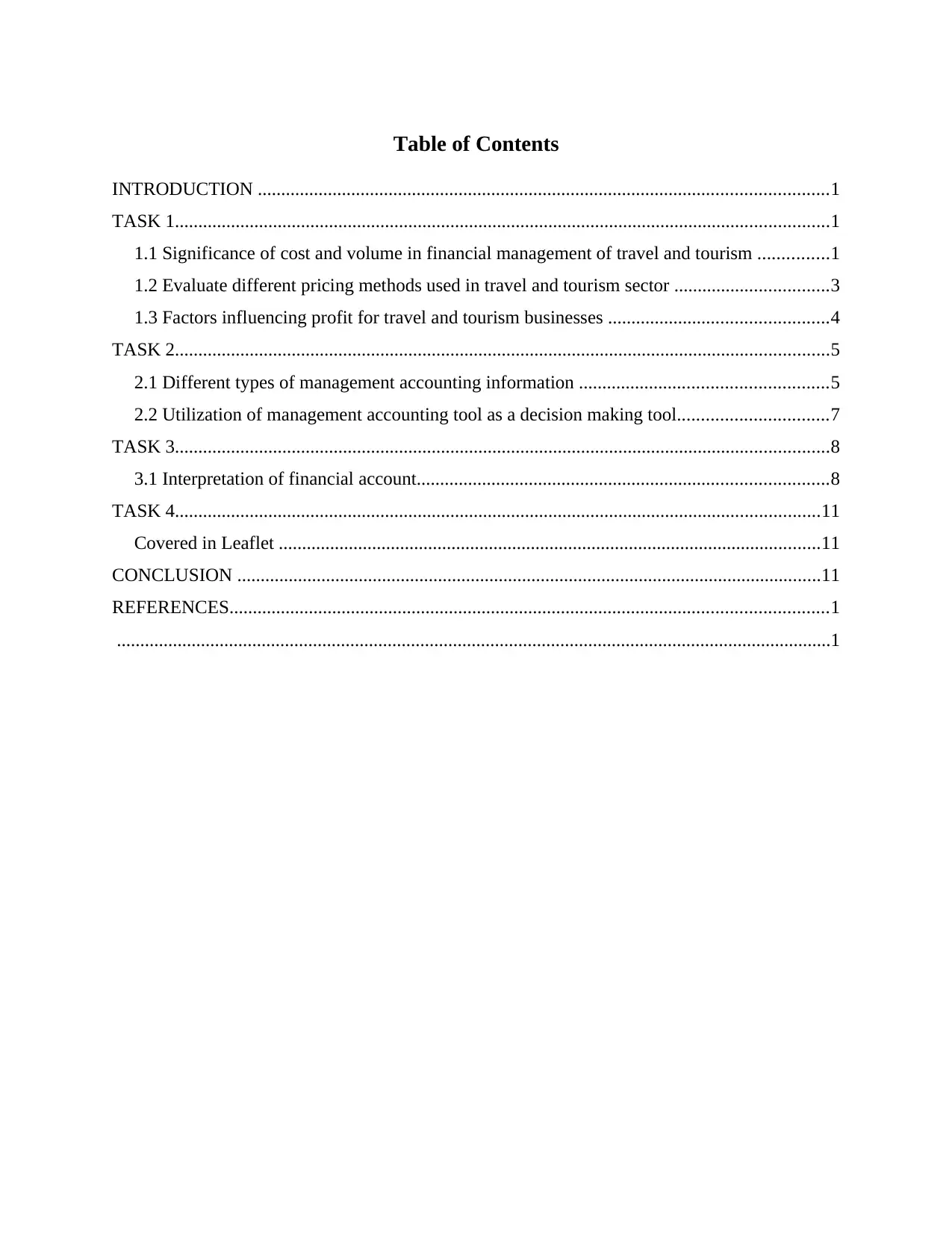
Table of Contents
INTRODUCTION ..........................................................................................................................1
TASK 1............................................................................................................................................1
1.1 Significance of cost and volume in financial management of travel and tourism ...............1
1.2 Evaluate different pricing methods used in travel and tourism sector .................................3
1.3 Factors influencing profit for travel and tourism businesses ...............................................4
TASK 2............................................................................................................................................5
2.1 Different types of management accounting information .....................................................5
2.2 Utilization of management accounting tool as a decision making tool................................7
TASK 3............................................................................................................................................8
3.1 Interpretation of financial account........................................................................................8
TASK 4..........................................................................................................................................11
Covered in Leaflet ....................................................................................................................11
CONCLUSION .............................................................................................................................11
REFERENCES................................................................................................................................1
.........................................................................................................................................................1
INTRODUCTION ..........................................................................................................................1
TASK 1............................................................................................................................................1
1.1 Significance of cost and volume in financial management of travel and tourism ...............1
1.2 Evaluate different pricing methods used in travel and tourism sector .................................3
1.3 Factors influencing profit for travel and tourism businesses ...............................................4
TASK 2............................................................................................................................................5
2.1 Different types of management accounting information .....................................................5
2.2 Utilization of management accounting tool as a decision making tool................................7
TASK 3............................................................................................................................................8
3.1 Interpretation of financial account........................................................................................8
TASK 4..........................................................................................................................................11
Covered in Leaflet ....................................................................................................................11
CONCLUSION .............................................................................................................................11
REFERENCES................................................................................................................................1
.........................................................................................................................................................1
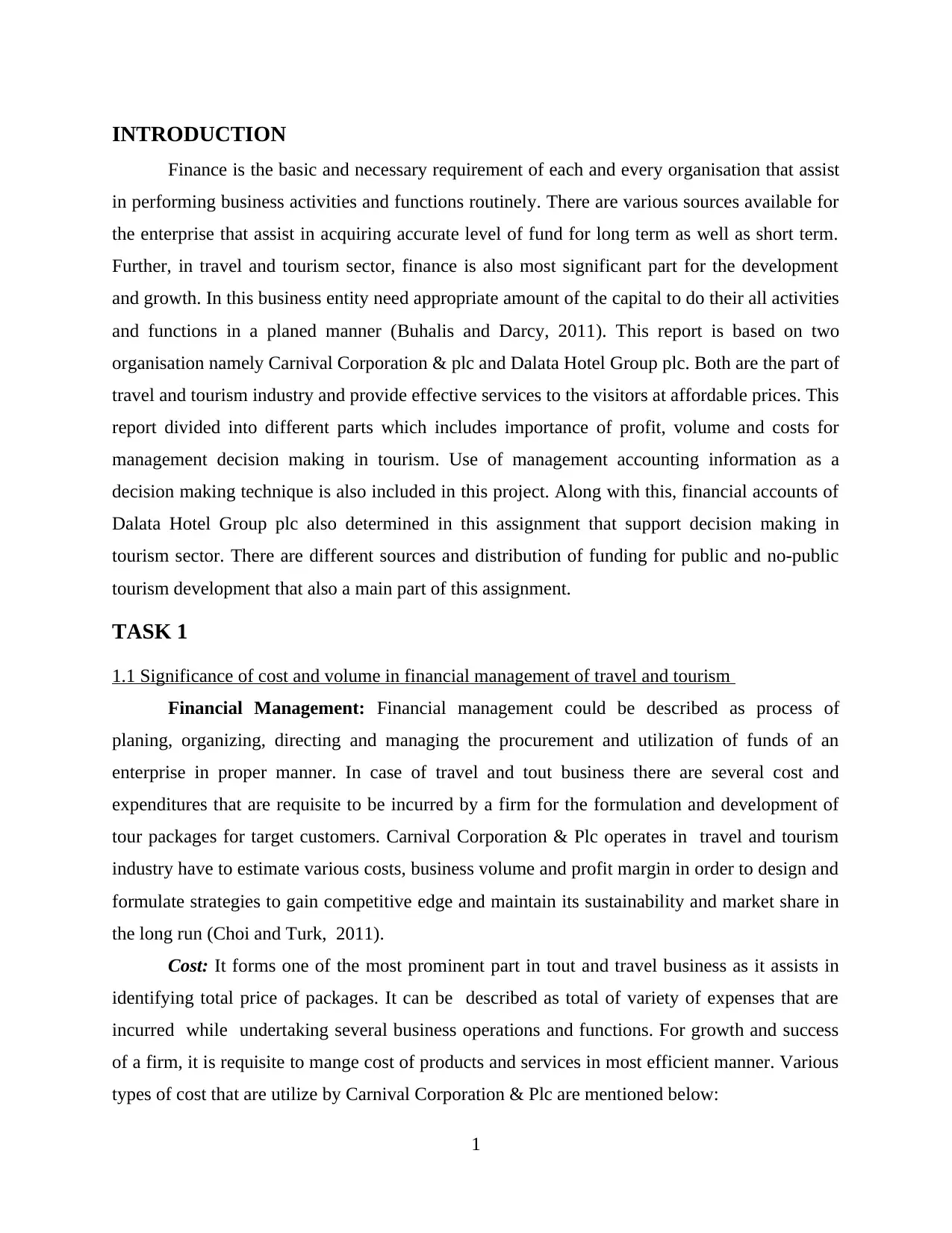
INTRODUCTION
Finance is the basic and necessary requirement of each and every organisation that assist
in performing business activities and functions routinely. There are various sources available for
the enterprise that assist in acquiring accurate level of fund for long term as well as short term.
Further, in travel and tourism sector, finance is also most significant part for the development
and growth. In this business entity need appropriate amount of the capital to do their all activities
and functions in a planed manner (Buhalis and Darcy, 2011). This report is based on two
organisation namely Carnival Corporation & plc and Dalata Hotel Group plc. Both are the part of
travel and tourism industry and provide effective services to the visitors at affordable prices. This
report divided into different parts which includes importance of profit, volume and costs for
management decision making in tourism. Use of management accounting information as a
decision making technique is also included in this project. Along with this, financial accounts of
Dalata Hotel Group plc also determined in this assignment that support decision making in
tourism sector. There are different sources and distribution of funding for public and no-public
tourism development that also a main part of this assignment.
TASK 1
1.1 Significance of cost and volume in financial management of travel and tourism
Financial Management: Financial management could be described as process of
planing, organizing, directing and managing the procurement and utilization of funds of an
enterprise in proper manner. In case of travel and tout business there are several cost and
expenditures that are requisite to be incurred by a firm for the formulation and development of
tour packages for target customers. Carnival Corporation & Plc operates in travel and tourism
industry have to estimate various costs, business volume and profit margin in order to design and
formulate strategies to gain competitive edge and maintain its sustainability and market share in
the long run (Choi and Turk, 2011).
Cost: It forms one of the most prominent part in tout and travel business as it assists in
identifying total price of packages. It can be described as total of variety of expenses that are
incurred while undertaking several business operations and functions. For growth and success
of a firm, it is requisite to mange cost of products and services in most efficient manner. Various
types of cost that are utilize by Carnival Corporation & Plc are mentioned below:
1
Finance is the basic and necessary requirement of each and every organisation that assist
in performing business activities and functions routinely. There are various sources available for
the enterprise that assist in acquiring accurate level of fund for long term as well as short term.
Further, in travel and tourism sector, finance is also most significant part for the development
and growth. In this business entity need appropriate amount of the capital to do their all activities
and functions in a planed manner (Buhalis and Darcy, 2011). This report is based on two
organisation namely Carnival Corporation & plc and Dalata Hotel Group plc. Both are the part of
travel and tourism industry and provide effective services to the visitors at affordable prices. This
report divided into different parts which includes importance of profit, volume and costs for
management decision making in tourism. Use of management accounting information as a
decision making technique is also included in this project. Along with this, financial accounts of
Dalata Hotel Group plc also determined in this assignment that support decision making in
tourism sector. There are different sources and distribution of funding for public and no-public
tourism development that also a main part of this assignment.
TASK 1
1.1 Significance of cost and volume in financial management of travel and tourism
Financial Management: Financial management could be described as process of
planing, organizing, directing and managing the procurement and utilization of funds of an
enterprise in proper manner. In case of travel and tout business there are several cost and
expenditures that are requisite to be incurred by a firm for the formulation and development of
tour packages for target customers. Carnival Corporation & Plc operates in travel and tourism
industry have to estimate various costs, business volume and profit margin in order to design and
formulate strategies to gain competitive edge and maintain its sustainability and market share in
the long run (Choi and Turk, 2011).
Cost: It forms one of the most prominent part in tout and travel business as it assists in
identifying total price of packages. It can be described as total of variety of expenses that are
incurred while undertaking several business operations and functions. For growth and success
of a firm, it is requisite to mange cost of products and services in most efficient manner. Various
types of cost that are utilize by Carnival Corporation & Plc are mentioned below:
1
⊘ This is a preview!⊘
Do you want full access?
Subscribe today to unlock all pages.

Trusted by 1+ million students worldwide

Direct Cost: It involves expense incurred on direct expenditures on services that are
offered by firm in travel and tourism. It involves cost of business packages that are
provided to consumers such ad hotel, food, spa etc. These costs directly relates with unit. Indirect Cost: It is also known as overheads or indirect costs. It involves expense that
are incurred on peripheral activities like hiring, advertising, property rents , printing
brochures etc. Fixed Cost: This is fixed expense that is remains unchanged. It assists Carnival
Corporation Plc to decrease total costs of its tour and travel packages (Evans,
Stonehouse and Campbell, 2012). It generally involves contract payment to vendors or
suppliers, depreciation, lighting expenses etc. Variable cost: This cost is variable or fluctuating in its nature and changes as any
variation occurs in the number of consumers in Carnival Corporation & Plc. It involves
expense on hiring cabs , recruiting new employees, transportation charges etc. Allocation: This expense is related with definite business process, project or division. It
is incurred when indirect expense are allocated to cost objectives. For instance, sales
costs etc. Appointment: It is an accounting technique for attributing cost to a specific cost
objective. It is process of sharing expenditure incurred by team among individual funding
program being implemented.
Volume: Carnival Corporation & Plc is a global firm offering its services around the globe. The
firm make use of a number of tools and techniques to calculate ideal volume of travel and tour
package that produced higher profits like economic order quantity, break even points etc.
Break Even Analysis: It is used to determine level where in Carnival Corporation & Plc
can get return on their total cost incurred and level after which company is likeable to earn
profits. It is the point where total cost is equal top total profits of firm (Henderson, 2010).
Economies of Scale: It is achieved when more units of services are offered by firm which
reduces its cost per unit. Thus, with an increase in its production, firm gets chance to decrease it
overall cost.
Diseconomies of Scale: It involves cost disadvantages that are accrue by firms and
governments because of enhancement in firm's output or size that results in increment in
production of goods and services at enhanced per cost per unit.
2
offered by firm in travel and tourism. It involves cost of business packages that are
provided to consumers such ad hotel, food, spa etc. These costs directly relates with unit. Indirect Cost: It is also known as overheads or indirect costs. It involves expense that
are incurred on peripheral activities like hiring, advertising, property rents , printing
brochures etc. Fixed Cost: This is fixed expense that is remains unchanged. It assists Carnival
Corporation Plc to decrease total costs of its tour and travel packages (Evans,
Stonehouse and Campbell, 2012). It generally involves contract payment to vendors or
suppliers, depreciation, lighting expenses etc. Variable cost: This cost is variable or fluctuating in its nature and changes as any
variation occurs in the number of consumers in Carnival Corporation & Plc. It involves
expense on hiring cabs , recruiting new employees, transportation charges etc. Allocation: This expense is related with definite business process, project or division. It
is incurred when indirect expense are allocated to cost objectives. For instance, sales
costs etc. Appointment: It is an accounting technique for attributing cost to a specific cost
objective. It is process of sharing expenditure incurred by team among individual funding
program being implemented.
Volume: Carnival Corporation & Plc is a global firm offering its services around the globe. The
firm make use of a number of tools and techniques to calculate ideal volume of travel and tour
package that produced higher profits like economic order quantity, break even points etc.
Break Even Analysis: It is used to determine level where in Carnival Corporation & Plc
can get return on their total cost incurred and level after which company is likeable to earn
profits. It is the point where total cost is equal top total profits of firm (Henderson, 2010).
Economies of Scale: It is achieved when more units of services are offered by firm which
reduces its cost per unit. Thus, with an increase in its production, firm gets chance to decrease it
overall cost.
Diseconomies of Scale: It involves cost disadvantages that are accrue by firms and
governments because of enhancement in firm's output or size that results in increment in
production of goods and services at enhanced per cost per unit.
2
Paraphrase This Document
Need a fresh take? Get an instant paraphrase of this document with our AI Paraphraser

1.2 Evaluate different pricing methods used in travel and tourism sector
Travel and tourism industry is the fastest growing industry across the world. Main role of
this industry is to provide effective and better services to the visitors at affordable price. Beside
this Carnival Corporation & Plc which is a part of tourism that use different kind of pricing
strategy are determined as under:
Market led pricing: It is a pricing method in which firm analysis the price of tour
package that are existing in the marketplace by the challengers (Heung, Kucukusta and Song,
2011). Administration of the Carnival Corporation & Plc should evaluate costs of their facilities
given by the rivals and set appropriate values in accordance to the comparative report between
their competitors and tour packages. In this business entity set prices of their packages lower or
higher from the values of similar goods in order to maximise turnover and earn maximum
amount of the capital.
Cost-Plus pricing: It is another pricing method which is adopted by the Carnival
Corporation & Plc in order to set tour package as per the requirement of visitors. As per this
approach an organisation can measure tour package cost including indirect and direct and them
add a profit margin percentage to them. In this Carnival Corporation & Plc measure a break even
point (BEP) so that it can gain accurate profits and revenues on their investments or finance in
business organisation.
Absorption pricing: It is an effective pricing method in which entire costs of the products
and services are recovered. It consider the variable cost of each and every products plus a per
capita of fixed costs. Few of the direct costs included with manufacturing a items and tourism
services includes wages for employees physically manufacturing a good, the raw material
applied in producing a services or goods. By applying this strategy, it is more easy for Carnival
Corporation & Plc in order to derive cost of their holiday package.
Contribution pricing: It is an another type of pricing strategy which maximise the
profitability ratio that are approaching from tourism services or items (Nielsen and Spenceley,
2011). In this, price of tour package is maintained as per its share in order to cover fixed value.
Here, supposition lies among fluctuation between product price, variable cost covered and
different number of products sold.
Top down: It is a type of pricing strategy or policy in which differentiation of price is
analysed by company from the closest challengers and what it explain regarding what prices
3
Travel and tourism industry is the fastest growing industry across the world. Main role of
this industry is to provide effective and better services to the visitors at affordable price. Beside
this Carnival Corporation & Plc which is a part of tourism that use different kind of pricing
strategy are determined as under:
Market led pricing: It is a pricing method in which firm analysis the price of tour
package that are existing in the marketplace by the challengers (Heung, Kucukusta and Song,
2011). Administration of the Carnival Corporation & Plc should evaluate costs of their facilities
given by the rivals and set appropriate values in accordance to the comparative report between
their competitors and tour packages. In this business entity set prices of their packages lower or
higher from the values of similar goods in order to maximise turnover and earn maximum
amount of the capital.
Cost-Plus pricing: It is another pricing method which is adopted by the Carnival
Corporation & Plc in order to set tour package as per the requirement of visitors. As per this
approach an organisation can measure tour package cost including indirect and direct and them
add a profit margin percentage to them. In this Carnival Corporation & Plc measure a break even
point (BEP) so that it can gain accurate profits and revenues on their investments or finance in
business organisation.
Absorption pricing: It is an effective pricing method in which entire costs of the products
and services are recovered. It consider the variable cost of each and every products plus a per
capita of fixed costs. Few of the direct costs included with manufacturing a items and tourism
services includes wages for employees physically manufacturing a good, the raw material
applied in producing a services or goods. By applying this strategy, it is more easy for Carnival
Corporation & Plc in order to derive cost of their holiday package.
Contribution pricing: It is an another type of pricing strategy which maximise the
profitability ratio that are approaching from tourism services or items (Nielsen and Spenceley,
2011). In this, price of tour package is maintained as per its share in order to cover fixed value.
Here, supposition lies among fluctuation between product price, variable cost covered and
different number of products sold.
Top down: It is a type of pricing strategy or policy in which differentiation of price is
analysed by company from the closest challengers and what it explain regarding what prices
3
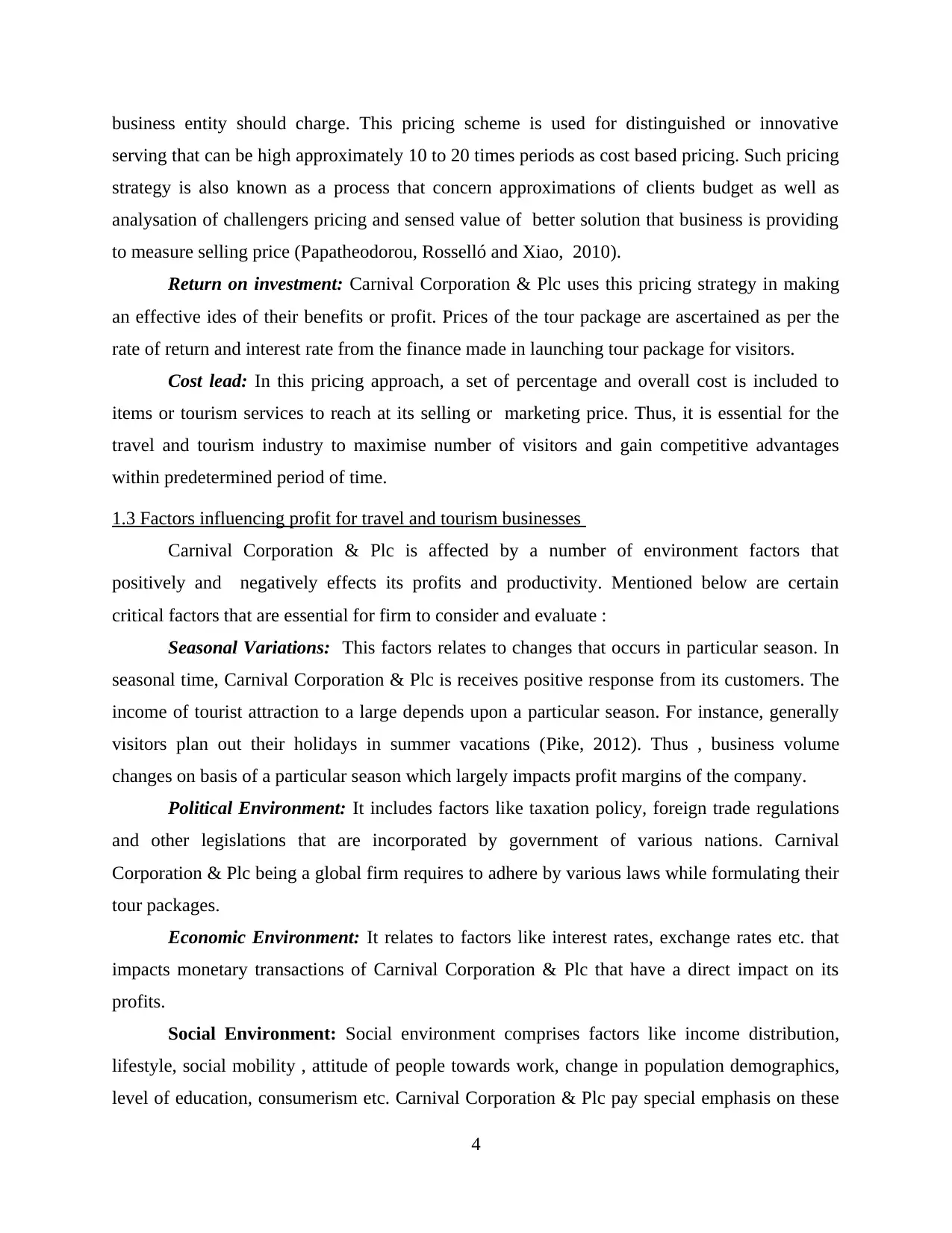
business entity should charge. This pricing scheme is used for distinguished or innovative
serving that can be high approximately 10 to 20 times periods as cost based pricing. Such pricing
strategy is also known as a process that concern approximations of clients budget as well as
analysation of challengers pricing and sensed value of better solution that business is providing
to measure selling price (Papatheodorou, Rosselló and Xiao, 2010).
Return on investment: Carnival Corporation & Plc uses this pricing strategy in making
an effective ides of their benefits or profit. Prices of the tour package are ascertained as per the
rate of return and interest rate from the finance made in launching tour package for visitors.
Cost lead: In this pricing approach, a set of percentage and overall cost is included to
items or tourism services to reach at its selling or marketing price. Thus, it is essential for the
travel and tourism industry to maximise number of visitors and gain competitive advantages
within predetermined period of time.
1.3 Factors influencing profit for travel and tourism businesses
Carnival Corporation & Plc is affected by a number of environment factors that
positively and negatively effects its profits and productivity. Mentioned below are certain
critical factors that are essential for firm to consider and evaluate :
Seasonal Variations: This factors relates to changes that occurs in particular season. In
seasonal time, Carnival Corporation & Plc is receives positive response from its customers. The
income of tourist attraction to a large depends upon a particular season. For instance, generally
visitors plan out their holidays in summer vacations (Pike, 2012). Thus , business volume
changes on basis of a particular season which largely impacts profit margins of the company.
Political Environment: It includes factors like taxation policy, foreign trade regulations
and other legislations that are incorporated by government of various nations. Carnival
Corporation & Plc being a global firm requires to adhere by various laws while formulating their
tour packages.
Economic Environment: It relates to factors like interest rates, exchange rates etc. that
impacts monetary transactions of Carnival Corporation & Plc that have a direct impact on its
profits.
Social Environment: Social environment comprises factors like income distribution,
lifestyle, social mobility , attitude of people towards work, change in population demographics,
level of education, consumerism etc. Carnival Corporation & Plc pay special emphasis on these
4
serving that can be high approximately 10 to 20 times periods as cost based pricing. Such pricing
strategy is also known as a process that concern approximations of clients budget as well as
analysation of challengers pricing and sensed value of better solution that business is providing
to measure selling price (Papatheodorou, Rosselló and Xiao, 2010).
Return on investment: Carnival Corporation & Plc uses this pricing strategy in making
an effective ides of their benefits or profit. Prices of the tour package are ascertained as per the
rate of return and interest rate from the finance made in launching tour package for visitors.
Cost lead: In this pricing approach, a set of percentage and overall cost is included to
items or tourism services to reach at its selling or marketing price. Thus, it is essential for the
travel and tourism industry to maximise number of visitors and gain competitive advantages
within predetermined period of time.
1.3 Factors influencing profit for travel and tourism businesses
Carnival Corporation & Plc is affected by a number of environment factors that
positively and negatively effects its profits and productivity. Mentioned below are certain
critical factors that are essential for firm to consider and evaluate :
Seasonal Variations: This factors relates to changes that occurs in particular season. In
seasonal time, Carnival Corporation & Plc is receives positive response from its customers. The
income of tourist attraction to a large depends upon a particular season. For instance, generally
visitors plan out their holidays in summer vacations (Pike, 2012). Thus , business volume
changes on basis of a particular season which largely impacts profit margins of the company.
Political Environment: It includes factors like taxation policy, foreign trade regulations
and other legislations that are incorporated by government of various nations. Carnival
Corporation & Plc being a global firm requires to adhere by various laws while formulating their
tour packages.
Economic Environment: It relates to factors like interest rates, exchange rates etc. that
impacts monetary transactions of Carnival Corporation & Plc that have a direct impact on its
profits.
Social Environment: Social environment comprises factors like income distribution,
lifestyle, social mobility , attitude of people towards work, change in population demographics,
level of education, consumerism etc. Carnival Corporation & Plc pay special emphasis on these
4
⊘ This is a preview!⊘
Do you want full access?
Subscribe today to unlock all pages.

Trusted by 1+ million students worldwide
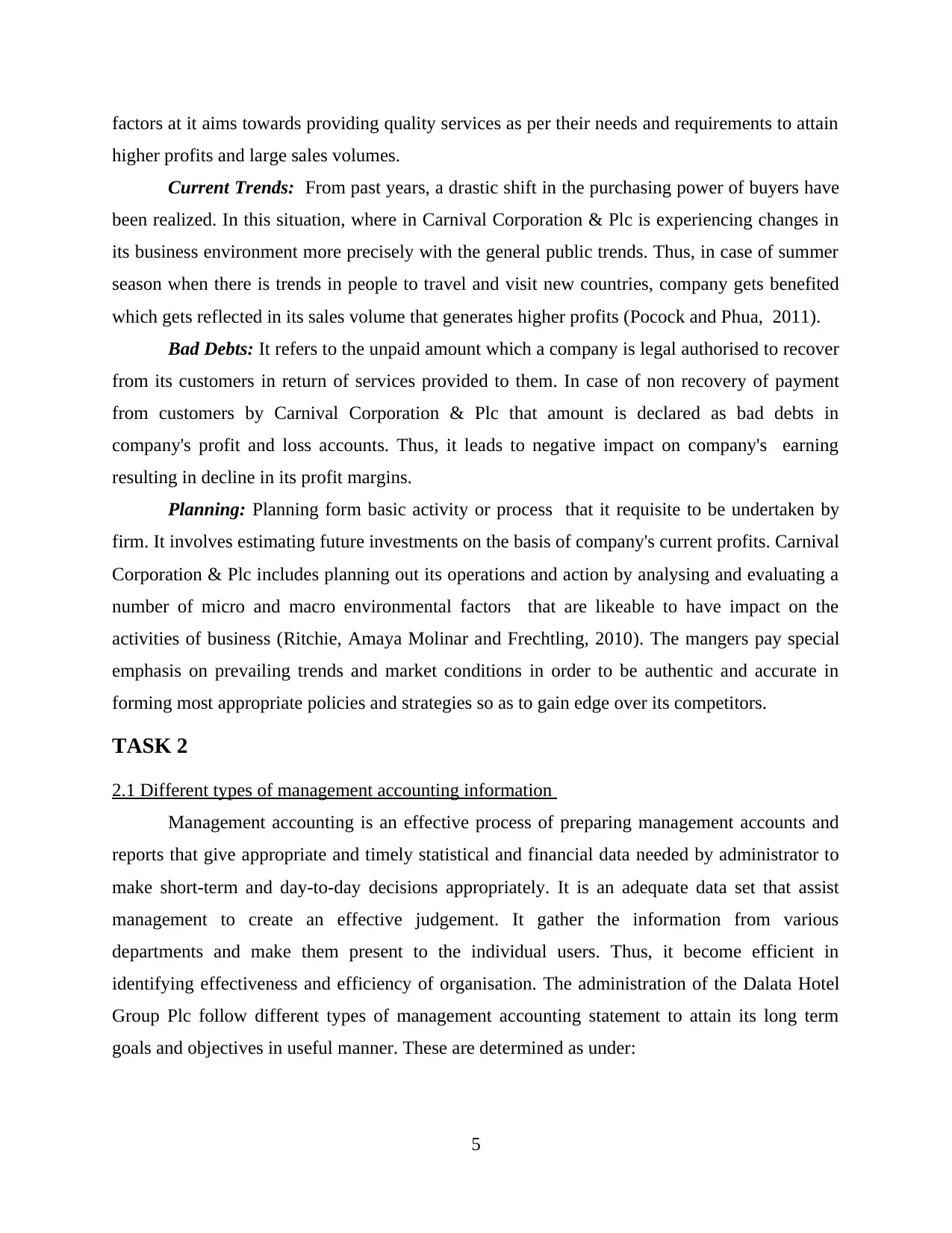
factors at it aims towards providing quality services as per their needs and requirements to attain
higher profits and large sales volumes.
Current Trends: From past years, a drastic shift in the purchasing power of buyers have
been realized. In this situation, where in Carnival Corporation & Plc is experiencing changes in
its business environment more precisely with the general public trends. Thus, in case of summer
season when there is trends in people to travel and visit new countries, company gets benefited
which gets reflected in its sales volume that generates higher profits (Pocock and Phua, 2011).
Bad Debts: It refers to the unpaid amount which a company is legal authorised to recover
from its customers in return of services provided to them. In case of non recovery of payment
from customers by Carnival Corporation & Plc that amount is declared as bad debts in
company's profit and loss accounts. Thus, it leads to negative impact on company's earning
resulting in decline in its profit margins.
Planning: Planning form basic activity or process that it requisite to be undertaken by
firm. It involves estimating future investments on the basis of company's current profits. Carnival
Corporation & Plc includes planning out its operations and action by analysing and evaluating a
number of micro and macro environmental factors that are likeable to have impact on the
activities of business (Ritchie, Amaya Molinar and Frechtling, 2010). The mangers pay special
emphasis on prevailing trends and market conditions in order to be authentic and accurate in
forming most appropriate policies and strategies so as to gain edge over its competitors.
TASK 2
2.1 Different types of management accounting information
Management accounting is an effective process of preparing management accounts and
reports that give appropriate and timely statistical and financial data needed by administrator to
make short-term and day-to-day decisions appropriately. It is an adequate data set that assist
management to create an effective judgement. It gather the information from various
departments and make them present to the individual users. Thus, it become efficient in
identifying effectiveness and efficiency of organisation. The administration of the Dalata Hotel
Group Plc follow different types of management accounting statement to attain its long term
goals and objectives in useful manner. These are determined as under:
5
higher profits and large sales volumes.
Current Trends: From past years, a drastic shift in the purchasing power of buyers have
been realized. In this situation, where in Carnival Corporation & Plc is experiencing changes in
its business environment more precisely with the general public trends. Thus, in case of summer
season when there is trends in people to travel and visit new countries, company gets benefited
which gets reflected in its sales volume that generates higher profits (Pocock and Phua, 2011).
Bad Debts: It refers to the unpaid amount which a company is legal authorised to recover
from its customers in return of services provided to them. In case of non recovery of payment
from customers by Carnival Corporation & Plc that amount is declared as bad debts in
company's profit and loss accounts. Thus, it leads to negative impact on company's earning
resulting in decline in its profit margins.
Planning: Planning form basic activity or process that it requisite to be undertaken by
firm. It involves estimating future investments on the basis of company's current profits. Carnival
Corporation & Plc includes planning out its operations and action by analysing and evaluating a
number of micro and macro environmental factors that are likeable to have impact on the
activities of business (Ritchie, Amaya Molinar and Frechtling, 2010). The mangers pay special
emphasis on prevailing trends and market conditions in order to be authentic and accurate in
forming most appropriate policies and strategies so as to gain edge over its competitors.
TASK 2
2.1 Different types of management accounting information
Management accounting is an effective process of preparing management accounts and
reports that give appropriate and timely statistical and financial data needed by administrator to
make short-term and day-to-day decisions appropriately. It is an adequate data set that assist
management to create an effective judgement. It gather the information from various
departments and make them present to the individual users. Thus, it become efficient in
identifying effectiveness and efficiency of organisation. The administration of the Dalata Hotel
Group Plc follow different types of management accounting statement to attain its long term
goals and objectives in useful manner. These are determined as under:
5
Paraphrase This Document
Need a fresh take? Get an instant paraphrase of this document with our AI Paraphraser

Budget Report: Budget report is a part of internal statement applied by administrator to
compare the budgeted, estimated projections with the real performance number attained during a
time period. In addition, such report is made to analyze how close the budgeted execution was to
the real performance in an accounting period. Thus, it is identified as one of the main and
essential way to get information about the business performance in figure manner. This report is
applied to evaluate both sets of information (Spenceley, 2012). An instance budget statement
typically follows the similar information as an income statement. The revenues and sales are
listed first preceded by the selling expenses, cost of goods sold, administrative and general
expenses, many other expenditure and lastly a net operating income amount. It is benefited to the
Dalata Hotel Group Plc to get appropriate amount of the information and achieve better
outcomes easily.
Financial Statement: It is also a part of reports prepared by an organisation
administration to instant the financial position and performance at a point in period. An actual
purpose set of financial statements mainly includes a income statement, balance sheet, cash flow
statement and owner's equity. These evidence are prepared in order to provide users outside of
the organisation like creditors and investors, more data regarding the financial positions of
company. Thus, it is also useful and essential part of the management accounting information
which assist the Dalata Hotel Group Plc to do their all activities and functions in an appropriate
manner.
Variance Analysis: It is the report of deviation of real behaviour versus planned or
forecasted behaviour in management and budgeting accounting. It is essentially and effectively
related with how the difference of planned and actual behaviours show how performance of
company is state impacted (Spencer and Zembani, 2011). It is important and essential part of the
management accounting information which assist the Dalata Hotel Group Plc to recognise
appropriate information about the tourism products and services. So that they are capable to
easily fulfill basis needs and requirements of the customers easily. Further such information also
assist the company to gain better outcomes and comparative advantages within predetermined
time duration.
Management information system: It is another important and essential part of the
management accounting information which assist the business to analysis accurate amount of the
data. MIS is a broadly applied and used term for a 3 resources system needed for effective
6
compare the budgeted, estimated projections with the real performance number attained during a
time period. In addition, such report is made to analyze how close the budgeted execution was to
the real performance in an accounting period. Thus, it is identified as one of the main and
essential way to get information about the business performance in figure manner. This report is
applied to evaluate both sets of information (Spenceley, 2012). An instance budget statement
typically follows the similar information as an income statement. The revenues and sales are
listed first preceded by the selling expenses, cost of goods sold, administrative and general
expenses, many other expenditure and lastly a net operating income amount. It is benefited to the
Dalata Hotel Group Plc to get appropriate amount of the information and achieve better
outcomes easily.
Financial Statement: It is also a part of reports prepared by an organisation
administration to instant the financial position and performance at a point in period. An actual
purpose set of financial statements mainly includes a income statement, balance sheet, cash flow
statement and owner's equity. These evidence are prepared in order to provide users outside of
the organisation like creditors and investors, more data regarding the financial positions of
company. Thus, it is also useful and essential part of the management accounting information
which assist the Dalata Hotel Group Plc to do their all activities and functions in an appropriate
manner.
Variance Analysis: It is the report of deviation of real behaviour versus planned or
forecasted behaviour in management and budgeting accounting. It is essentially and effectively
related with how the difference of planned and actual behaviours show how performance of
company is state impacted (Spencer and Zembani, 2011). It is important and essential part of the
management accounting information which assist the Dalata Hotel Group Plc to recognise
appropriate information about the tourism products and services. So that they are capable to
easily fulfill basis needs and requirements of the customers easily. Further such information also
assist the company to gain better outcomes and comparative advantages within predetermined
time duration.
Management information system: It is another important and essential part of the
management accounting information which assist the business to analysis accurate amount of the
data. MIS is a broadly applied and used term for a 3 resources system needed for effective
6
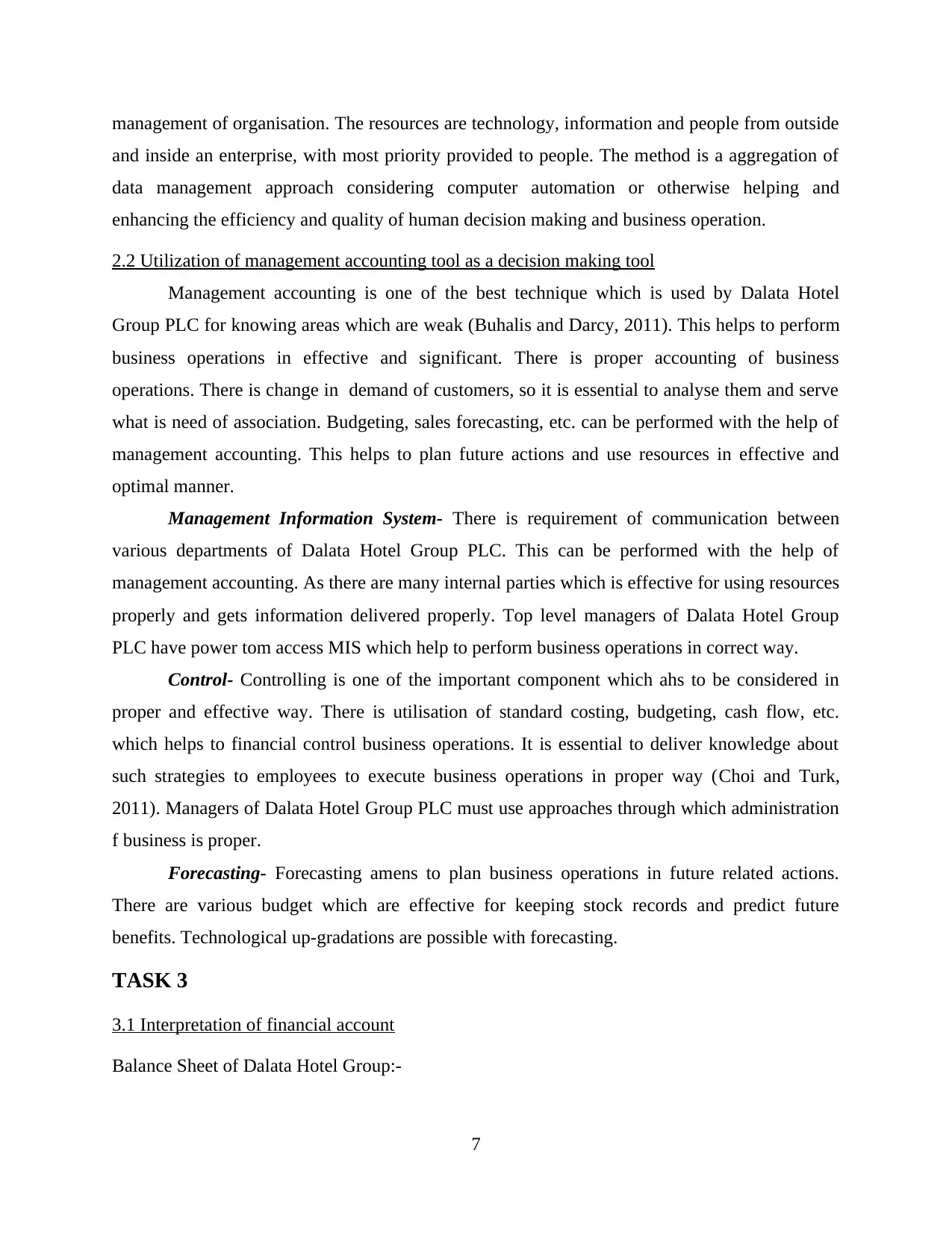
management of organisation. The resources are technology, information and people from outside
and inside an enterprise, with most priority provided to people. The method is a aggregation of
data management approach considering computer automation or otherwise helping and
enhancing the efficiency and quality of human decision making and business operation.
2.2 Utilization of management accounting tool as a decision making tool
Management accounting is one of the best technique which is used by Dalata Hotel
Group PLC for knowing areas which are weak (Buhalis and Darcy, 2011). This helps to perform
business operations in effective and significant. There is proper accounting of business
operations. There is change in demand of customers, so it is essential to analyse them and serve
what is need of association. Budgeting, sales forecasting, etc. can be performed with the help of
management accounting. This helps to plan future actions and use resources in effective and
optimal manner.
Management Information System- There is requirement of communication between
various departments of Dalata Hotel Group PLC. This can be performed with the help of
management accounting. As there are many internal parties which is effective for using resources
properly and gets information delivered properly. Top level managers of Dalata Hotel Group
PLC have power tom access MIS which help to perform business operations in correct way.
Control- Controlling is one of the important component which ahs to be considered in
proper and effective way. There is utilisation of standard costing, budgeting, cash flow, etc.
which helps to financial control business operations. It is essential to deliver knowledge about
such strategies to employees to execute business operations in proper way (Choi and Turk,
2011). Managers of Dalata Hotel Group PLC must use approaches through which administration
f business is proper.
Forecasting- Forecasting amens to plan business operations in future related actions.
There are various budget which are effective for keeping stock records and predict future
benefits. Technological up-gradations are possible with forecasting.
TASK 3
3.1 Interpretation of financial account
Balance Sheet of Dalata Hotel Group:-
7
and inside an enterprise, with most priority provided to people. The method is a aggregation of
data management approach considering computer automation or otherwise helping and
enhancing the efficiency and quality of human decision making and business operation.
2.2 Utilization of management accounting tool as a decision making tool
Management accounting is one of the best technique which is used by Dalata Hotel
Group PLC for knowing areas which are weak (Buhalis and Darcy, 2011). This helps to perform
business operations in effective and significant. There is proper accounting of business
operations. There is change in demand of customers, so it is essential to analyse them and serve
what is need of association. Budgeting, sales forecasting, etc. can be performed with the help of
management accounting. This helps to plan future actions and use resources in effective and
optimal manner.
Management Information System- There is requirement of communication between
various departments of Dalata Hotel Group PLC. This can be performed with the help of
management accounting. As there are many internal parties which is effective for using resources
properly and gets information delivered properly. Top level managers of Dalata Hotel Group
PLC have power tom access MIS which help to perform business operations in correct way.
Control- Controlling is one of the important component which ahs to be considered in
proper and effective way. There is utilisation of standard costing, budgeting, cash flow, etc.
which helps to financial control business operations. It is essential to deliver knowledge about
such strategies to employees to execute business operations in proper way (Choi and Turk,
2011). Managers of Dalata Hotel Group PLC must use approaches through which administration
f business is proper.
Forecasting- Forecasting amens to plan business operations in future related actions.
There are various budget which are effective for keeping stock records and predict future
benefits. Technological up-gradations are possible with forecasting.
TASK 3
3.1 Interpretation of financial account
Balance Sheet of Dalata Hotel Group:-
7
⊘ This is a preview!⊘
Do you want full access?
Subscribe today to unlock all pages.

Trusted by 1+ million students worldwide
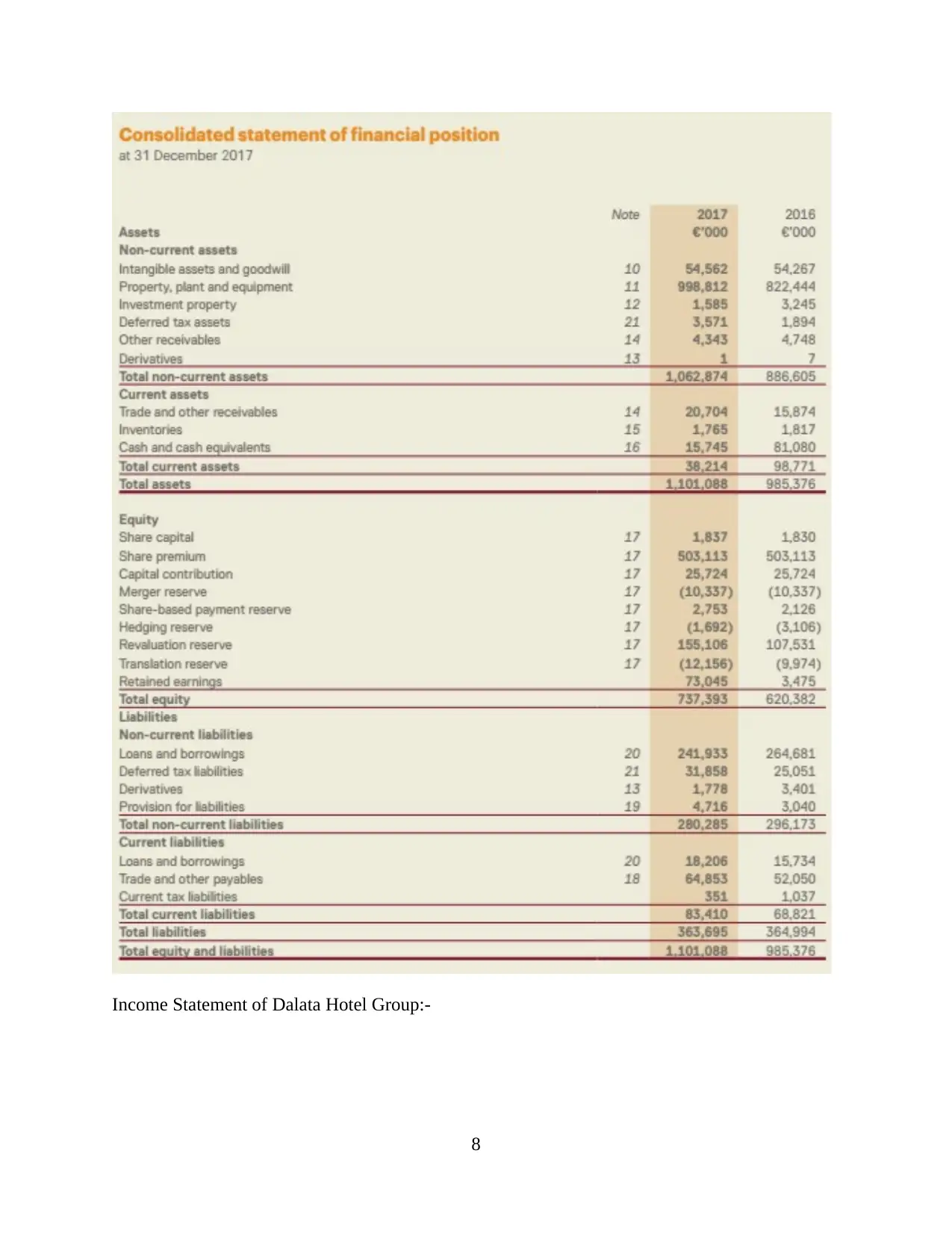
Income Statement of Dalata Hotel Group:-
8
8
Paraphrase This Document
Need a fresh take? Get an instant paraphrase of this document with our AI Paraphraser
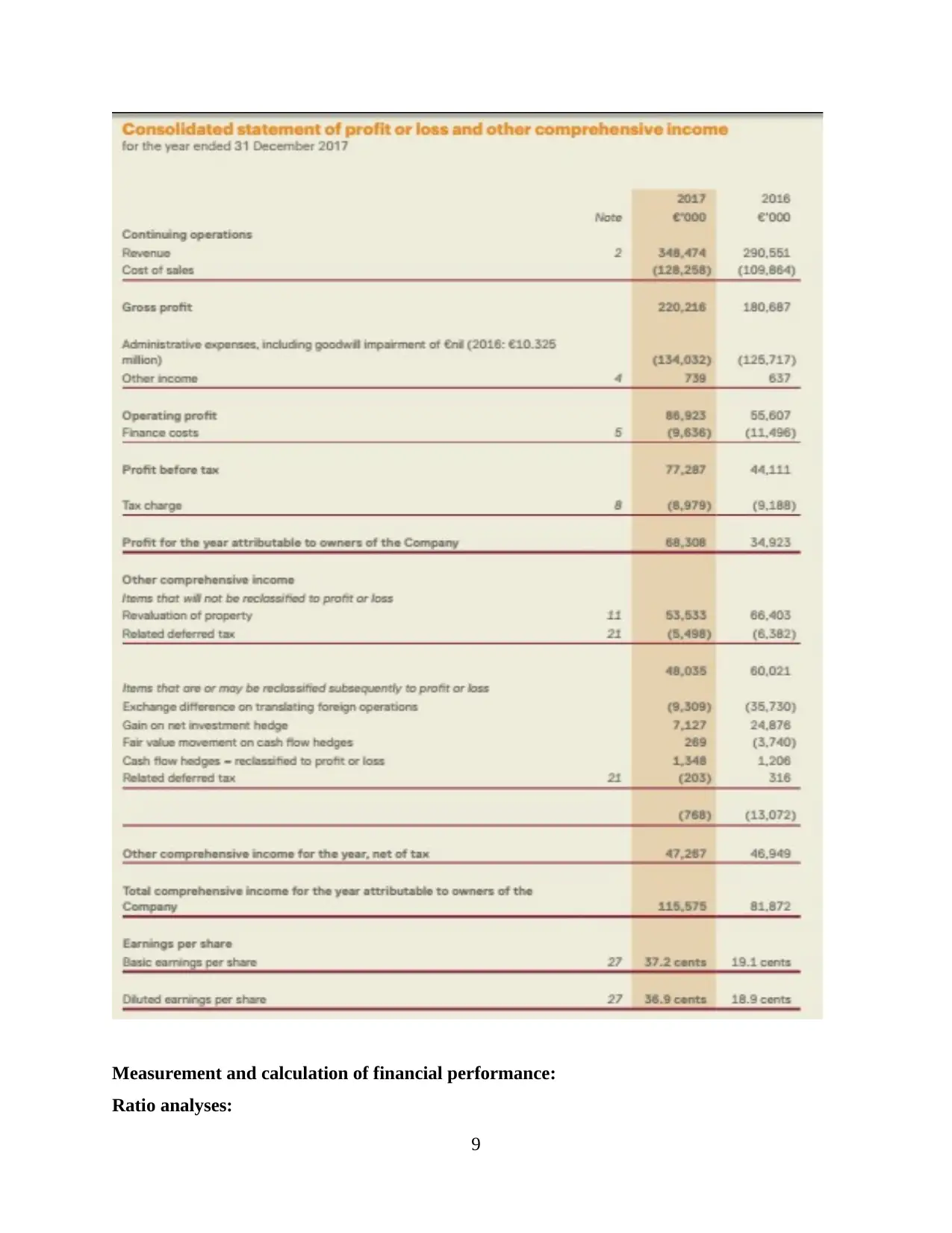
Measurement and calculation of financial performance:
Ratio analyses:
9
Ratio analyses:
9
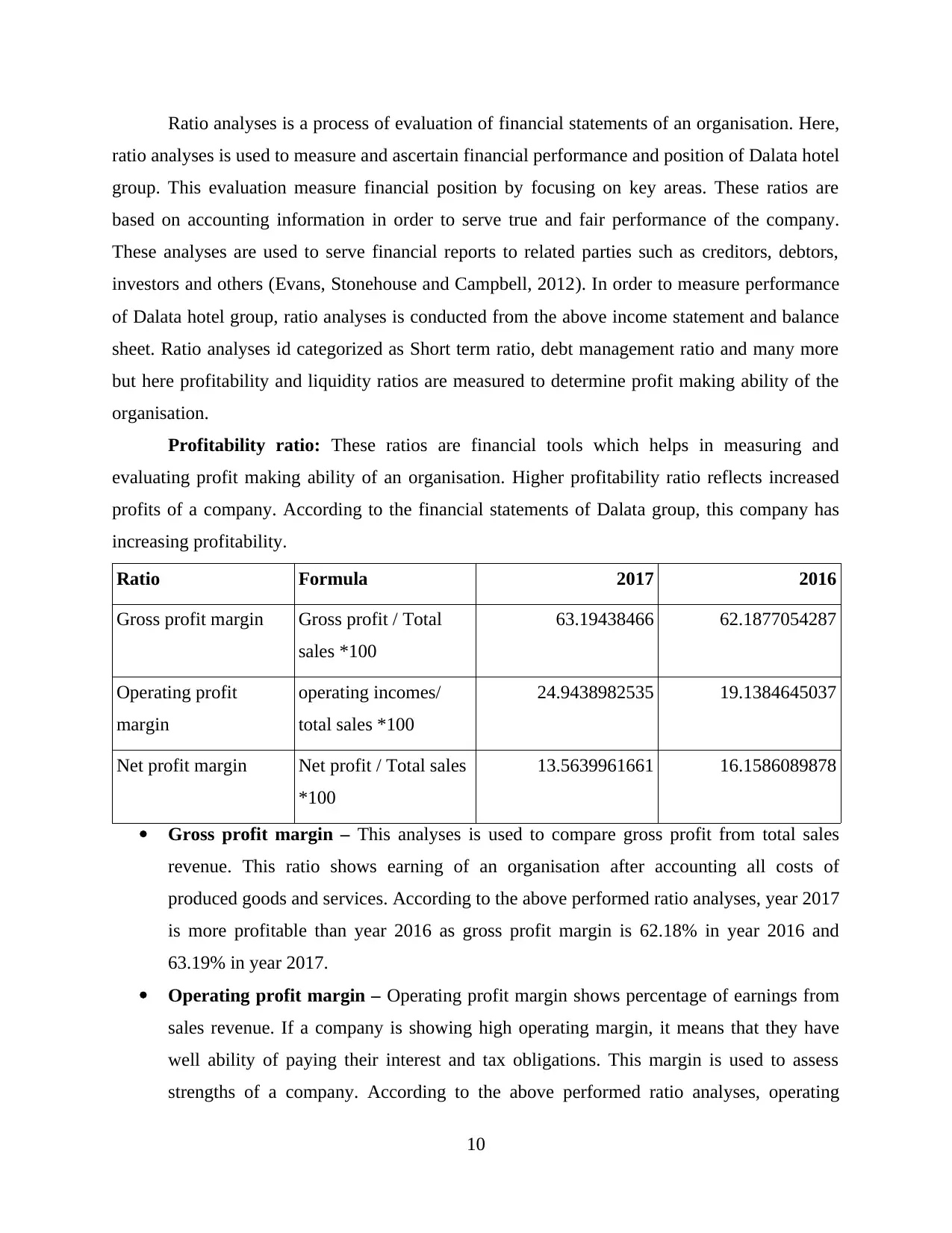
Ratio analyses is a process of evaluation of financial statements of an organisation. Here,
ratio analyses is used to measure and ascertain financial performance and position of Dalata hotel
group. This evaluation measure financial position by focusing on key areas. These ratios are
based on accounting information in order to serve true and fair performance of the company.
These analyses are used to serve financial reports to related parties such as creditors, debtors,
investors and others (Evans, Stonehouse and Campbell, 2012). In order to measure performance
of Dalata hotel group, ratio analyses is conducted from the above income statement and balance
sheet. Ratio analyses id categorized as Short term ratio, debt management ratio and many more
but here profitability and liquidity ratios are measured to determine profit making ability of the
organisation.
Profitability ratio: These ratios are financial tools which helps in measuring and
evaluating profit making ability of an organisation. Higher profitability ratio reflects increased
profits of a company. According to the financial statements of Dalata group, this company has
increasing profitability.
Ratio Formula 2017 2016
Gross profit margin Gross profit / Total
sales *100
63.19438466 62.1877054287
Operating profit
margin
operating incomes/
total sales *100
24.9438982535 19.1384645037
Net profit margin Net profit / Total sales
*100
13.5639961661 16.1586089878
Gross profit margin – This analyses is used to compare gross profit from total sales
revenue. This ratio shows earning of an organisation after accounting all costs of
produced goods and services. According to the above performed ratio analyses, year 2017
is more profitable than year 2016 as gross profit margin is 62.18% in year 2016 and
63.19% in year 2017.
Operating profit margin – Operating profit margin shows percentage of earnings from
sales revenue. If a company is showing high operating margin, it means that they have
well ability of paying their interest and tax obligations. This margin is used to assess
strengths of a company. According to the above performed ratio analyses, operating
10
ratio analyses is used to measure and ascertain financial performance and position of Dalata hotel
group. This evaluation measure financial position by focusing on key areas. These ratios are
based on accounting information in order to serve true and fair performance of the company.
These analyses are used to serve financial reports to related parties such as creditors, debtors,
investors and others (Evans, Stonehouse and Campbell, 2012). In order to measure performance
of Dalata hotel group, ratio analyses is conducted from the above income statement and balance
sheet. Ratio analyses id categorized as Short term ratio, debt management ratio and many more
but here profitability and liquidity ratios are measured to determine profit making ability of the
organisation.
Profitability ratio: These ratios are financial tools which helps in measuring and
evaluating profit making ability of an organisation. Higher profitability ratio reflects increased
profits of a company. According to the financial statements of Dalata group, this company has
increasing profitability.
Ratio Formula 2017 2016
Gross profit margin Gross profit / Total
sales *100
63.19438466 62.1877054287
Operating profit
margin
operating incomes/
total sales *100
24.9438982535 19.1384645037
Net profit margin Net profit / Total sales
*100
13.5639961661 16.1586089878
Gross profit margin – This analyses is used to compare gross profit from total sales
revenue. This ratio shows earning of an organisation after accounting all costs of
produced goods and services. According to the above performed ratio analyses, year 2017
is more profitable than year 2016 as gross profit margin is 62.18% in year 2016 and
63.19% in year 2017.
Operating profit margin – Operating profit margin shows percentage of earnings from
sales revenue. If a company is showing high operating margin, it means that they have
well ability of paying their interest and tax obligations. This margin is used to assess
strengths of a company. According to the above performed ratio analyses, operating
10
⊘ This is a preview!⊘
Do you want full access?
Subscribe today to unlock all pages.

Trusted by 1+ million students worldwide
1 out of 15
Related Documents
Your All-in-One AI-Powered Toolkit for Academic Success.
+13062052269
info@desklib.com
Available 24*7 on WhatsApp / Email
![[object Object]](/_next/static/media/star-bottom.7253800d.svg)
Unlock your academic potential
Copyright © 2020–2026 A2Z Services. All Rights Reserved. Developed and managed by ZUCOL.





